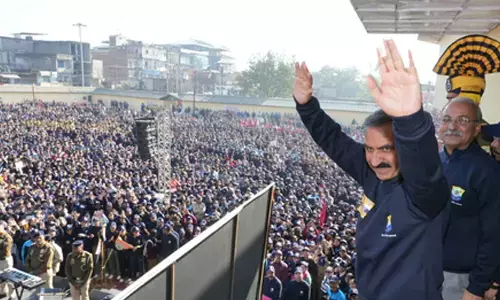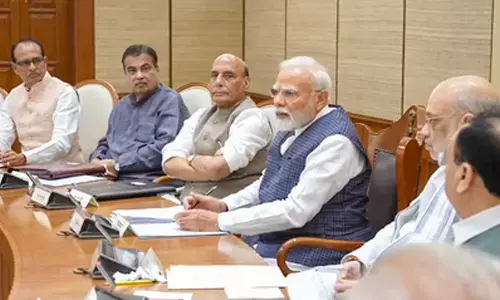Missing targets of Make in India

Having been voted to Power in 2014, the present government has taken a transform agenda for the development of the country It identified Transform, Energise and Clean TEC as the major plank of their government Consequently, it had also earmarked a major chunk of the Budget Allocations
Having been voted to Power in 2014, the present government has taken a ‘transform agenda’ for the development of the country. It identified ‘Transform, Energise and Clean (TEC)’ as the major plank of their government. Consequently, it had also earmarked a major chunk of the Budget Allocations. One major programme thought to help transform the economy has been the ‘Make in India’, launched on September 7, 2014, with the aim of fostering innovation, building best manufacturing and infrastructure making it easy to do business and enhancing skill development. By now, four years have passed since its launching.
The government of India having made the review came out with a scorecard focusing on three major areas of achievement viz., Foreign Direct Investment (FDI), Ease of Doing Business (EDB) and Sector Specific Progress up to December 2017. The government feels that it has made a major breakthrough in terms of FDI growing by USD 160.79 billion between April 2014 and March 2017 (representing 33 per cent of the cumulative FDI since 2000); the rank on the EDB improving the 30 places to 100 in 2018 and to 77 in 2019 and there have been significant gains in sectors like Aerospace and Defence, Aviation, Basic Metals and Cement, Biotechnology, Capital Goods, Automobiles, Chemicals, Food Processing, Gems and Jewellery, ICTE Manufacturing, Leather, New and Renewable Energy, Pharmaceuticals, Power, Railways, Shipping, Tourism and MSME.
An in-depth analysis of the programme brings to the fore many an aberration. The data of the Department of Industrial Policy and Promotion (DIPP) on FDI reveals the fact that the total FDI received during the four-year period from 2014-15 to 2017-18 amounted to Rs 22,890 crore. Of this, the amount that was mobilised by way equity stood at only 71.5 per cent. More specifically, the growth rate in the FDI during the last two years hovered at only 8.00 per cent in 2016-17 and 3.00 per cent in 2017-18. Another interesting fact is that about 52 per cent of this FDI had flown from only two countries viz Mauritius and Singapore, which are considered tax heavens.
As a matter of fact, the success of the programme needs to be evaluated from the stand point of breadth and depth of savings and investment taking place across different sectors of the economy. Viewed from this perspective, the Economic Survey (2017-18) brings to light not so heartening picture. The Gross Capital Formation (GCF) as percent of Gross Domestic Product (GDP) has declined by about 5.6 percentage points between 2011-12 and 2015-16.
On the savings front, though the private corporate sector has noted a modest growth (from 9,5 to 12 per cent), the savings of the household sector registered a steep decline (from 23.6. to 19.2 percent). The data of the RBI since 2015-16 shows that there was a significant decline in household savings made in the form of bank deposits and life insurance funds but recorded recognisable hike in the currency holdings. This is not a congenial feature of an economy purported to be heading for a double-digit growth.
The index of Industrial Production (IIP) which is considered yet another crucial indicator in judging the performance of the industry has been faltering of late. Even during the period of four years from 2014-15 to 2017-18, there was only a marginal increase in the overall IIP from 4.00 per cent in 2014-15 to 4.4 percent in 2017-18. If compared in terms of monthly progress, there had been violent fluctuations in the indicators. During the previous Financial Year (2017-18 April-March), the Index varied between the lowest of minus 0.3 percent (June 2017) to the highest of 8.5 per cent (November 2017). In the current financial year, the deviations fluctuated between 3.5 in May to 6.5 in July and in September, IIP stood at 4.5 percent. The deviations clearly indicate the inconsistency in the performance of the economy suggesting a corrective action.
On the issue of ‘job creation’ as a consequence of ‘Make in India’, there has been utter confusion prevailing on the number of jobs created thus far. The data of the agencies involved is at large variance. The Centre for Monitoring Indian Economy has estimated that the number of jobs created in 2017 are only 1.43 million; whereas the NITI Ayog put the figure at 7.00 million. The Employees Provident Fund organisation got into the controversy by declaring that the total jobs created stood at 3.00 million during the period of six months (from September 2017 to February 2018).
The Indian Labour Bureau had a different estimate of only 2.00 lakh between April 2017 and September 2017; whereas the number of job seekers is estimated to be growing at the rate of 12 to 16 million a year. While this being the factual position, the government makes a tall claim of creating 2.00 crore jobs a year. Unless these issues are sorted out and aberrations corrected, it is quite unlikely to meet the targets of ‘Make in India’ programme.
(K. Viyyanna Rao - The writer is former VC– ANU and presently Director, SEA Group of Institutions)















